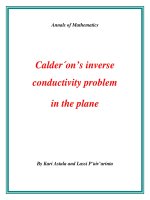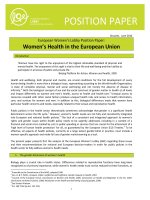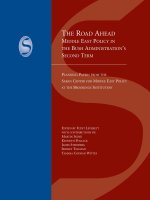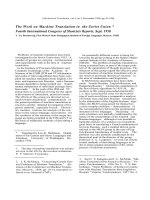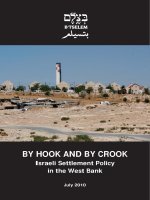ramet s. p. religious policy in the soviet union. cambridge, 2005
Bạn đang xem bản rút gọn của tài liệu. Xem và tải ngay bản đầy đủ của tài liệu tại đây (6.49 MB, 381 trang )
Church-state relations have undergone a number of changes during the seven
decades of
the
existence of
the
Soviet Union. In the 1920s the state was politically
and
financially
weak and its edicts often ignored, but the 1930s saw the beginning
of an era of systematic anti-religious persecution. There was some relaxation in the
last decade of Stalin's rule, but under Khrushchev, the pressure on the church was
again stepped up. In the Brezhnev period this was moderated to a policy of
slow
strangulation, and Gorbachev's leadership saw a thorough liberalisation and re-
legitimation of religion. This book brings together fifteen of the West's leading
scholars of religion in the USSR, and provides the most comprehensive analysis of
the subject yet undertaken. Bringing much hitherto unknown material to light, the
authors discuss the policy apparatus, programmes of atheisation and socialisation,
cults and sects, and the world of Christianity.Religious policy
in the Soviet UnionReligious policy
in
the Soviet
Union
EDITED
BY
Sabrina Petra Ramet
Associate Professor of International Studies
University of Washington
CAMBRIDGE
UNIVERSITY PRESS
CAMBRIDGE UNIVERSITY PRESS
Cambridge, New York, Melbourne, Madrid, Cape Town, Singapore, Sao Paulo
Cambridge University Press
The Edinburgh Building, Cambridge CB2 2RU, UK
Published in the United States of America by Cambridge University Press, New York
www.cambridge.org
Information on this title: www.cambridge.org/9780521416436
© Cambridge University Press 1993
This publication is in copyright. Subject to statutory exception
and to the provisions of relevant collective licensing agreements,
no reproduction of any part may take place without
the written permission of Cambridge University Press.
First published 1993
This digitally printed first paperback version 2005
A catalogue record for this publication is available from the British Library
Library of Congress Cataloguing in Publication data
Religious policy in the Soviet Union/edited by Sabrina Petra Ramet.
p.
cm.
Includes index.
ISBN 0-521-41643-4 (hard)
1.
Church and state - Soviet Union - History - 1917- 2. Soviet
Union - Religion - 1917- I. Ramet, Sabrina
P.,
1949-
BR936.R47 1992
261.7'0947-dc20 91-39817 CIP
ISBN-13 978-0-521-41643-6 hardback
ISBN-10 0-521-41643-4 hardback
ISBN-13 978-0-521-02230-9 paperback
ISBN-10 0-521-02230-4 paperback
For Jack
Dull,
friend:
You helped to
get me
through
a difficult year
Notes on contributors page
xi
Preface
xvii
SABRINA PETRA RAMET
Part
I
Introduction
1.
A survey of Soviet religious policy
3
PHILIP WALTERS
2.
Religious policy in the era of Gorbachev
31
SABRINA PETRA RAMET
Part II Policy apparatus
3.
The Council for Religious Affairs
55
OTTO LUGHTERHANDT
4.
Some reflections about religious policy under Kharchev
84
JANE ELLIS
5.
The state, the church, and the oikumene: the Russian
Orthodox Church and the World Council of Churches,
1948-1985
105
J.
A.
HEBLY
Part III Education, socialisation, and values
6. Fear no evil: schools and religion in Soviet Russia,
1917-1941
125
LARRY
E.
HOLMES
7.
Soviet schools, atheism and religion
158
JOHN DUNSTAN
8. The Ten Commandments as values in Soviet people's
consciousness
187
SAMUEL
A.
KLIGER
and
PAUL
H. DE
VRIES
ix
X CONTENTS
9. Out of the kitchen, out of the temple: religion, atheism and
women in the Soviet Union
206
JOHN ANDERSON
Part IV Cults and sects
10.
Dilemmas of the spirit: religion and atheism in the Yakut-
Sakha Republic
231
MARJORIE MANDELSTAM BALZER
11.
The spread of modern cults in the USSR
252
OXANA ANTIC
Part V The world of Christianity
12.
The Russian Orthodox Renovationist Movement and its
Russian historiography during the Soviet period
273
ANATOLII LEVITIN-KRASNOV
13.
The
re-emergence
of the
Ukrainian (Greek) Catholic
Church in the USSR
292
MYROSLAW TATARYN
14.
Protestantism in the USSR
319
WALTER SAWATSKY
15.
Epilogue: religion after the collapse
350
SABRINA PETRA RAMET
APPENDIX: Religious groups numbering 2,000 or more,
in the USSR
355
Index
357
Notes on contributors
SABRINA PETRA RAMET is an Associate Professor of International
Studies, University of Washington. Born in London, England, she was
educated at Stanford University (in philosophy) and received her
doctorate in political science from UCLA in 1981. She is the author of
five books: Nationalism and
Federalism
in Yugoslavia, 1963-1983 (Indiana
University Press, 1984; 2nd edn, covering the years 1962-1991,
published in 1992);
Cross
and
Commissar:
The Politics
of
Religion
in Eastern
Europe
and
the
USSR (Indiana University Press, 1987); The Soviet-Syrian
Relationship since
1955: A
Troubled Alliance
(Westview Press, 1990); Social
Currents
in Eastern
Europe:
The
Sources and
Meaning of the Great Transforma-
tion (Duke University Press, 1991); and Balkan Babel: Politics, Culture
and Religion
in
Yugoslavia
(Westview Press 1992). She is also the editor
of six books besides this one, and has authored more than 60 published
journal articles and book chapters. She has received numerous
awards, including a Fulbright-Hays Fellowship, a Kennan Institute
Research Grant, three short-term IREX grants, and, in 1990, a UW
Jackson School Award for Outstanding Service to Students.
JOHN ANDERSON was born in Gravesend, England, and studied at
the London School of Economics (where he completed his doctorate),
and Moscow State University. He is the author of numerous chapters
and articles on religion in the Soviet Union and Eastern Europe,
published in Religion in
Communist
Lands, Soviet Jewish Affairs, and
Soviet
Studies,
and is at present completing a book on the shaping of Soviet
religious policy from Khrushchev to Gorbachev. He is currently lec-
turer in international relations at the University of
St.
Andrews, hav-
ing previously taught Soviet and East European politics at the London
School of Economics and Edinburgh University.
OXANA ANTIC was born in Taganrog, on the Soviet Azov Sea. She is
xi
Xll NOTES ON CONTRIBUTORS
presently
a
researcher
at
Radio Free Europe/Radio Liberty
in
Munich, Germany. In addition to her regular contributions to Radio
Liberty's
Report on
the USSR, she delivers lectures on the situation of
churches in the Soviet Union, the moral and spiritual crisis, and the
role
of
Russian women. Her poems and short stories have been
published in two anthologies:
Spurensuche
(1989) and
Morgenrot im Nebel
(1991).
She contributed
a
chapter to Eastern Christianity and Politics in
the Twentieth
Century
(1988).
MARJORIE MANDELSTAM BALZER, born in Washington DC, teaches
in the Sociology and Russian Area Studies departments of Georgetown
University. She is editor of the journal
Soviet Anthropology
and Archeology,
and of the books Shamanism:
Soviet Studies
of
Traditional Religion
in
Siberia
and
Central
Asia (1990); and Russian Traditional Culture (1991). She has
held post-doctoral research appointments at Harvard, Columbia, and
the Wilson Centre's Kennan Institute. Using data from several years
of fieldwork
in
the Soviet Union, she has written on western and
eastern Siberian peoples and nationalities issues for
American
Anthropo-
logist, Slavic Review, Journal
of
Soviet Nationalities, Arctic Anthropology,
Social
Science
and Medicine, and Canadian Slavonic Review. Forthcoming
books include The
Tenacity
of Ethnicity, and
Siberian Women's
Lives: Yakut-
Sakha
Autobiographies.
JOHN DUNSTAN was born near Truro, Cornwall, England. He
is
Senior Lecturer
in
Soviet Education
at
the Centre for Russian and
East European Studies, University
of
Birmingham, and was, until
recently, the Centre's deputy director. He
is
the author of
Paths
to
Excellence
and the Soviet
School
(1978) and
of
V.
N.
Soroka-Rosinsky,
Soviet
Teacher, in Fact and Fiction (1991), and editor
of
Soviet
Education under
Scrutiny (1987) and Soviet Education under
Perestroika
(1992). He
is
the
former editor
of
Soviet Education Study Bulletin, and has contributed
articles
to
Soviet Studies, Compare, and Padagogik und Schule in Ost und
West.
He co-founded and has chaired the UK Study Group on Soviet
Education.
JANE ELLIS was born in Liverpool, England, and graduated in Rus-
sian language and literature from Birmingham University. She has
worked since then at Keston College, England, where she is currently
senior researcher. She
is
also former editor (1981-6) of
Religion
in
Communist
Lands,
to which she has contributed several articles. She is
the author of The Russian
Orthodox
Church:
A
Contemporary
History (1986)
and editor of
Religious
Minorities in the Soviet Union (4th edn, 1984). She
Notes on contributors
xiii
has also translated three books from Russian: An Early
Soviet
Saint: The
Life of Father Zachariah (1976),
Letters
from Moscow, by Father Gleb
Yakunin and Lev Regelson (1978), and
Three Generations
of Suffering, by
Georgi Vins (1979), and has contributed chapters to
Religious
Liberty in
the Soviet Union (1976), Eastern Christianity and Politics in the Twentieth
Century
(1988), and
Candle
in the Wind (1989).
j.
A. (HANS) HEBLY was born in the Netherlands and received his
doctorate in theology from Utrecht University. From 1949 to 1951 he
was an ecumenical fieldworker in the Cimade (in Paris), and from
1951 to 1970 served as a minister in the Dutch Reformed Church.
Since 1970, he has been a staff member of the Interacademic Institute
for Missiological and Ecumenical Research, in Utrecht, Netherlands,
of which he is currently director. He is the author of
The Russians and the
World Council of
Churches
(1978), The New Confession of Faith of the
Evangelical Christian Baptists
(1983,
in Dutch), Eastbound Ecumenism
(1986),
and other books.
LARRY E. HOLMES was born in Chicago, Illinois, in 1942. He is
currently Professor of History at the University of South Alabama,
where he has taught since 1968. His publications on Soviet historical
scholarship and on Soviet schools have appeared in Slavic Review,
History of Education
Quarterly,
and
Sovetskaia
pedagogika.
In 1991, Indiana
University Press published his The Kremlin and
the
Schoolhouse:
Reforming
Education
in
Soviet
Russia, 1917-1931. Holmes has received several grants
from the International Research and Exchanges Board and the Ken-
nan Institute for Advanced Russian Studies.
SAMUEL A. KLIGER was born in Brichany, Moldavia. He is the chair
of the International Research Institute on Values Changes, a scientific
society incorporated in New York. He is also Senior Researcher for the
Book Institute of the All-Union Book Chamber in Moscow. He com-
pleted his doctoral studies at the Academy of
the
Sciences in Moscow,
and specialises in research methodology and social structure.
ANATOLII LEVITIN-KRASNOV was born in Russia in 1915, and
spent seven years in a Soviet prison during the Stalin era. After his
rehabilitation in 1956, he began to write essays criticising the sup-
pression of religion in his country. In 1974, he was allowed to
emigrate, and moved to Lucerne, Switzerland. Subsequently, he
authored two classic works dealing with the Renovationist Church:
Ocherki po istorii russkoi tserkovnoi smuty (co-authored with Vadim
XIV
NOTES
ON
CONTRIBUTORS
Savrov, Kusnacht, Switzerland, 1977) and Likhie gody, 1925-1941
(Paris,
1977). He also wrote a biography of Orthodox Bishop
Vvedenskii. He died on 5 April 1991.
OTTO
LUGHTERHANDT
was born in Celle/Hannover, in Germany,
and studied at the Universities of Freiburg, Bonn, and Hamburg,
receiving his Doctor of Jurisprudence from Bonn in 1975. He is cur-
rently Professor of Public Law and Eastern Law at the University of
Hamburg. His principal publications are: Der
Sowjetstaat
und die
Russisch-Orthodoxe
Kirche (Cologne, 1976) and
UN-Menschenrechtskonven-
tion-Sowjetrecht-Sowjet-wirklichkeit. Ein kritischer Vergleich (1980). His
many articles dealing with human rights and religious freedom in
Eastern Europe and the Balkans have been published in various
journals.
WALTER
SAWATSKY
(born in Altona, Manitoba, Canada) is Associ-
ate Professor of Church History, Associated Mennonite Biblical
Seminaries, and also East-West Consultant for the Mennonite Central
Committee. He is the author of
Soviet Evangelicals since
World War Two
(1981),
and has contributed chapters to
Religion
and
Modernization
in the
Soviet Union (1978), Religion in
Communist Societies
(1982), and
Mennonites
in Russia (1990). His articles have appeared in Religion in Communist
Lands, OPREE, Journal of
Church
and
State,
and other journals.
MYROSLAW
TATARYN
was born in Manchester, England, and came
to Canada in 1963. An ordained Ukrainian Catholic priest, he
received his Master of Divinity from Toronto School of Theology in
1981,
and was ordained in Rome that same year. He has had various
pastoral assignments in different parts of southern Ontario, and, since
1988,
has served as executive director of St Sophia Religious Associa-
tion of Ukrainian Catholics (a charitable organisation). He has been
deeply involved with his church's recent resurgence in the USSR, and
is currently completing his Doctor of Theology degree at St Michael's
College, Toronto, where he also lectures. His articles have appeared in
Journal of
Ecumenical
Studies, Religion in
Communist
Lands,
Sobornost
1
,
and
other journals.
PAUL
H. DE VRIES, born in Grand Rapids, Michigan, is president of
the International Research Institute on Values Changes, based in
New York city. He also holds the chair in ethics and the marketplace
at King's College in New York. He completed doctoral studies in
philosophy at the University of Virginia and specialises in applied
Notes on contributors
xv
ethics.
He is author of
The Taming
of
the Shrewd
(published in February
1992).
PHILIP WALTERS was born in Cambridge, England, and is head of
research at Keston College and a former research fellow (1976-9) at
Cambridge University. He has written current affairs talks for the
BBC and has edited the journal
Religion
in
Communist
Lands.
He is
editor of Light Through the Curtain (1985) and World Christianity: Eastern
Europe (1989). His articles have appeared in Religion in Communist
Lands, Soviet Studies, Slavonic Review, and other journals. He has con-
tributed chapters to Eastern Christianity and Politics in the Twentieth Cen-
tury (1988),
Candle
in the Wind (1989), and
Christianity and Russian
Culture
in Soviet
Society
(1990).
This is a book about religious policy and policy makers in the USSR.
Its purpose is to shed light on the thinking, goals, assumptions,
methods, and instruments of policy. The essays collected herein
embrace a wide range of subjects, covering both historical and con-
temporary themes. Several chapters examine the institutions and
mechanics of Soviet religious policy, especially Otto Luchterhandt's
chapter on the Council of Religious Affairs. Jane Ellis' chapter on
Kharchev's revelations, and John Dunstan's chapter on education.
Other chapters concentrate rather on policy decisions and actions,
trying to account for changes and stabilities in the evolution of Soviet
religious policy. These include Philip Walters' chapter, along with
Larry Holmes' chapter on schools and religion in the period
1917-41,
John Anderson's chapter on women and religious policy, and my own
chapter on the Gorbachev era. Still other chapters focus on the
perspectives and drives of the religious organisations themselves, such
as Oxana Antic's chapter on modern
cults,
Jan Hebly's chapter on the
Russian Orthodox Church and ecumenism, Myroslaw Tataryn's
chapter on the re-emergence of the Greek-Rite Catholic Church in
Ukraine, and Marjorie Balzer's chapter on religion in Yakutia. The
contribution by Samuel Kliger and Paul de Vries takes a different
road, drawing upon extensive interview data to examine values and
normative attitudes among Soviet people. Finally, Anatolii Levitin-
Krasnov's chapter on the Living Church re-examines some of the
long-standing controversies surrounding this regime-backed schis-
matic movement. Taken collectively, these chapters cover a wide-
ranging array of subjects, many of them hitherto neglected in the past.
It is by now a stock phrase to say that the questions raised in a
particular field are as important as the answers. In practice, of course,
some answers are more important than others, and some answers are
more important than some questions. But, where the latter are con-
xvii
XV111
PREFACE
cerned, those which are most useful are those which organise the
material coherently and which take us closer to the inner spirit of the
subject. Such questions would include: What were Gorbachev's
ultimate goals in his religious policy? How was Soviet religious policy
related to policies in other spheres? Why were the Greek-Rite
Catholics, suppressed for more than 40 years, granted legalisation in
1989? What do the structures and procedures of the Council for Reli-
gious Affairs tell us about Soviet religious policy? How did changes in
Soviet sociological assessments of religion correlate with changes in
Soviet religious policy?
It is fashionable nowadays to question whether communism has any
future, and the ambiguous term 'post-communism' has come into
vogue. For a while, the old leaders in some countries (eg., the USSR,
Bulgaria, Albania) held onto their positions even as the entire power
structure was being transformed all around them. The tidal wave that
overthrew communism achieved its first successes in what was then
called the German Democratic Republic, as well as Poland, and
Czechoslovakia. The transition to pluralism took longer in the other
East European countries, as well as in the Soviet Union
itself.
As dramatic as the changes are, however, Gorbachev's reforms, and
for that matter, his vision, did not spring
ex
nihilo;
nor did they unfold
in a void. The system in which his reforms worked was a system built
on certain assumptions and which continued to reflect the residue of
those assumptions, even where they were being abandoned. This was
certainly the case until summer 1991; until then, neither the CPSU
monopoly nor the nomenklatura system had been abandoned, corrup-
tion and the resistance of middle-level officials remained problems
despite Gorbachev's efforts to overcome them, and the notion that
there should be an office for religious affairs in the first place seemed
not to be questioned. The system bequeathed to Gorbachev set the
agenda for reform, it conditioned the assumptions about what were the
central issues, it set the limits to reform (though these limits have
expanded steadily over time).
This book was launched at the end of 1986, when I was living in
Washington DC, and when the direction of Gorbachev's reforms in the
religious sphere, not to mention how long he would survive in office,
was not yet clear. The book was essentially complete only three years
later, and was later revised and updated in late 1990 and early 1991.
The 14 chapters assembled in this book therefore reflect reality as it
was in December 1990 or January 1991. Three chapters were sub-
sequently updated slightly, to reflect the post-coup changes and the
fall of Gorbachev, but without the possibility of a substantial
Preface xix
expansion of the text. The epilogue was added in January 1992 in
order to take some account of the impact of the intervening changes.
I am deeply indebted to Margaret Brown for translating Otto Luch-
terhandt's chapter from German and to George E. Rennar for translat-
ing Anatolii Levitin-Krasnov's chapter from Russian. The data
included in the appendix was originally collected for inclusion as a
supplement to my own chapter (2), but, given its general utility, I
have decided to place it in a separate appendix.
Sabrina Petra Ramet
I
Introduction
A survey of Soviet religious policy
PHILIP WALTERS
The first 70 years of Soviet power saw
a
sustained offensive against
religion on
a
scale unprecedented
in
history. Millions suffered and
died. There is a great deal of descriptive and anecdotal material about
these sufferings readily available, and
I
do not propose to reproduce
much of it here. My task in this chapter is to present the frame of
reference within which the anti-religious offensive took place, showing
what the legal and constitutional situation was, what was actual policy
at any given time (the two only rarely match),
or
(more often) the
failure of the various strategies and tactics.
The CPSU has always been dedicated
to
promoting the disap-
pearance of religion, but the formation and execution of a religious
policy has usually been subordinate to, and influenced by, other con-
stantly changing political, economic, and social considerations. Any
attempt to subdivide Soviet religious policy into successive chronologi-
cal phases tends, therefore, to be contentious, since exceptions to the
general norm
at
any date are always
to
be found, and within any
chosen phase there are policy modifications and even reversals. Never-
theless, just this kind of chronological approach is what
I
propose to
attempt. Within each chronological section
I
shall first consider offi-
cial policy towards religious institutions
and
towards individual
believers, showing where toleration ended and discrimination began;
and then
I
shall look at what efforts were being made in the
field
of
anti-religious education and propaganda.
Before moving on
to
the chronological survey, however,
I
shall
briefly consider some of the basic motives which have influenced those
responsible for shaping Soviet religious policy, and the institutional
framework within which such policy was developed. As archives begin
to open up in the Soviet Union, there will soon be a wealth of hitherto
inaccessible material to shed new light on all aspects of this complex
subject. Good work has already been done
by
scholars including
4 PHILIP WALTERS
Professor Bohdan Bociurkiw. Most of what follows in this introduction
is a summary of
his
findings.
1
A fundamental tenet of Marxism-Leninism
is
that religion will
ultimately disappear. If it began to seem unlikely to do so, the authori-
ties would naturally adopt measures to promote its disappearance,
since its continued presence was a rebuke to the claims of the ideology.
The above impulse was reinforced when the system developed into full
totalitarianism (in the USSR, from the late 1920s): the internal com-
pulsion of such
a
system demanded the liquidation of any social
institution (not just religious) which was not under its complete control.
Within this general context, there were two basic, and to some
extent conflicting, trends amongst those responsible for formulating
specific policies. The 'fundamentalists' were found primarily in the
Party's Agitation and Propaganda organisation and in the
Komsomol]
and the 'pragmatists' amongst those in the party and state executive
apparatus, and also in the secret police, who generally realised that
religious believers could be more easily controlled when allowed
a
(limited) legal existence rather than being driven underground. Each
trend held sway
at
different times; and their policies were further
modified by considerations of the changing party line in such
fields
as
internal and external security, agricultural and industrial policy,
policy towards the nationalities, and foreign affairs.
What of the institutional structure within which decisions were
made and implemented? It can be assumed that major policy decisions
were taken at the level of the Party's Politburo and the Council of
Ministers; but the information on which such decisions were based
would have surfaced through
a
variety of institutions which would
have made their own interpretations, selections and recommenda-
tions.
Let us look at some of these institutions.
From 1918, the implementation of religious policy was divided up
amongst various agencies. Within the Commissariat of Justice, a sub-
division which later became known as the Department of Cults was
charged with overall supervision. The Commissariat
of
Internal
Affairs was charged with more direct administration. The
Cheka —
the
first in
a
series of secret police organisations
-
was made responsible
for combating possible subversion by surveillance and infiltration. A
special department in the Commissariat of Enlightenment, under the
guidance of the Party's Agitation and Propaganda department, was
made responsible for anti-religious propaganda. Ad
hoc
bodies were
also set up to see particular projects through
-
for example, the 1922
committee on the confiscation of church treasures.
In 1922 a standing Commission, known informally as the 'Antireli-
A
survey
of
Soviet religious policy
5
gious Commission', was established at Central Committee level.
Headed by Emel'yan Yaroslavsky, it was to function as an overall co-
ordinating body throughout the 1920s.
In 1924, the Department of Cults was abolished. Its successor, the
Secretariat (later Permanent Commission) for the Affairs of Cults,
involved a more active role for the OGPU and later the NKVD (suc-
cessors to the
cheka,
i.e. the secret police) throughout the 1930s.
In 1925 Yaroslavsky was appointed head of a new mass atheistic
organisation set up under the auspices of the Agitation and Propa-
ganda department of the Central Committee: the League of Atheists
(in 1929 renamed the League of Militant Atheists). This body was
quietly dissolved early in the Second World War, to be replaced after
the War by the
Znanie
Society.
With the reversal of religious policy at this time, two new bodies
were set up: the Council for the Affairs of the Russian Orthodox
Church (CAROC) in 1943 and the Council for the Affairs of Religious
Cults (CARC) in 1944. They had all-Union powers and their purpose
was officially to facilitate contacts between the churches and the
government. In fact they turned out to be well adapted to facilitating
both direct infiltration of church structures by the security organs, and
the authorities' control over church activity. This became their chief
function under Khrushchev. In 1965 the two Councils were merged
into the single Council for Religious Affairs (CRA), which continued
to play the same role well into the Gorbachev era.
1917-1920
This was a period of acute crisis: would the fledgling Bolshevik state
survive? There was revolution and civil war, and, in response, War
Communism, with all its privations. There was also real revolutionary
zeal amongst the Bolsheviks and those they inspired. One element in
this was a genuine hostility towards religion, particularly as institu-
tionalised in the Russian Orthodox Church. For decades before the
Revolution, the progressive intelligentsia had been alienated from the
church, and during the last years of the Empire churchgoing had
actually been declining, particularly in the cities. In the immediate
post-Revolutionary years, it was indeed the conscious policy of the
Bolsheviks to direct their anti-religious activity virtually exclusively
against the Orthodox Church; but this did not mean that other
denominations and confessions were immune from sporadic attacks by
anti-religious enthusiasts.
2
The priority for the Bolsheviks at this time, then, was to seize the



